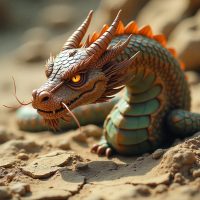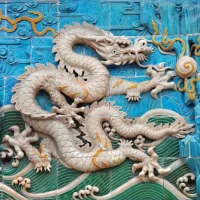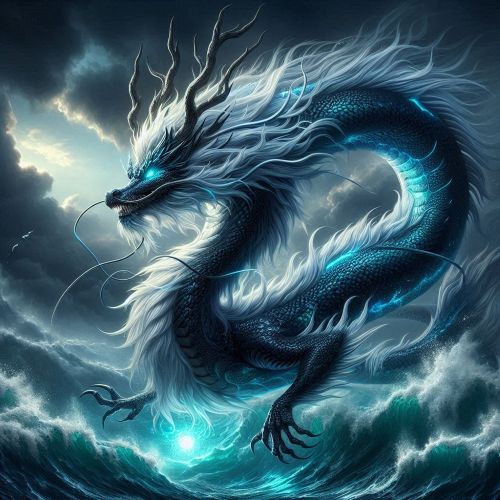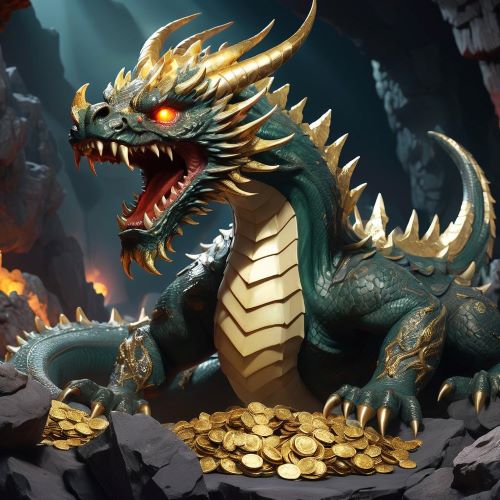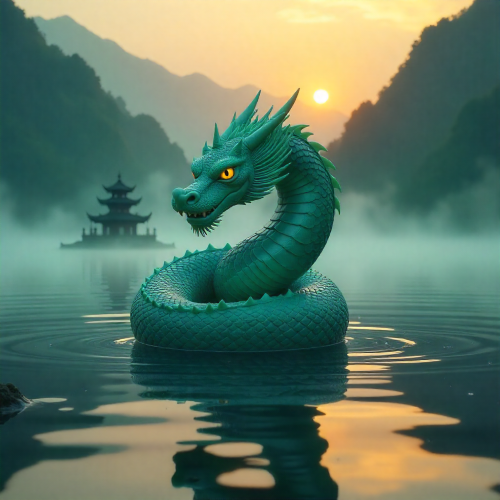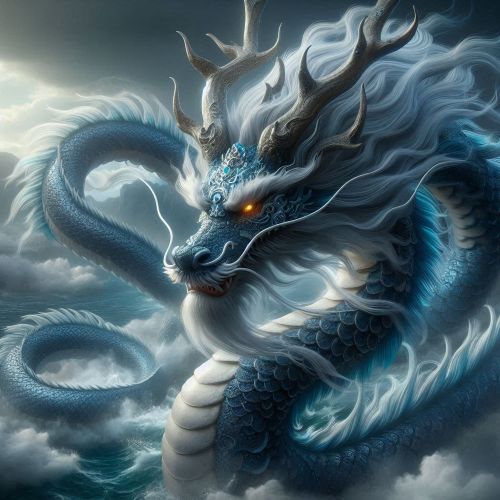Dilong : The Earth Dragon of China’s Hidden Realms
Listen
At a glance
| Description | |
|---|---|
| Origin | Chinese Mythology |
| Classification | Animals |
| Family Members | N/A |
| Region | China |
| Associated With | Earth, Underground water |
Dilong
Introduction
Dilong, known in Chinese as 地龙 or the Earth Dragon, is one of the most intriguing figures in Chinese mythology. Unlike the celestial Tianlong that rules the heavens or Shenlong that commands the rain, Dilong remains rooted in the terrain beneath human feet, governing the underground waters, natural soil systems, and the vitality of the land. Ancient texts place this dragon at the crossroads of myth and nature, portraying it as a guardian of rivers beneath the earth and a regulator of the planet’s internal energies. Its presence reflects the early Chinese understanding of how subterranean forces shape the world, making Dilong a symbol of stability, nourishment, and the unseen powers that sustain life.
Physical Traits
Dilong is traditionally imagined as a long, serpentine dragon with a body adapted to life below the earth’s surface. Its form blends elegance and raw power, shaped by its association with soil, rock, and flowing underground water. Classical Chinese dragon features such as a horned head, flowing whiskers, and clawed limbs remain, but they appear more subdued, emphasizing functionality rather than grandeur. Artists often depict Dilong in earthy shades of brown, green, and muted gold, giving its scales the appearance of mineral deposits or moist soil. Its body is sometimes described as smooth and flexible, capable of burrowing through the ground as effortlessly as swimming through water. Though wingless, Dilong is still believed to ascend into the sky when necessary, guided by the unseen force of its chimu, a mythical structure on its head said to enable flight. This blend of terrestrial and mystical traits aligns Dilong with natural cycles, portraying it as a creature that embodies the living heartbeat of the land.
Family
Like many dragons in Chinese tradition, Dilong is part of a symbolic rather than literal lineage. Its closest conceptual counterpart is Tianlong, the Heavenly Dragon, forming a powerful yin-yang duality of earth and sky. The balance between these two dragons reflects broader Daoist principles in which harmony is achieved when celestial and terrestrial forces operate in alignment. Dilong is also integrated into the larger family of elemental dragons that include Shenlong, the controller of storms, and Fuzanglong, the dragon associated with hidden treasures beneath the earth. These interconnected relationships emphasize the mythological belief that each domain of nature has a corresponding dragon guardian. Dilong’s role within this family anchors the foundation of the world itself, ensuring that all life depending on fertile soil and steady land can thrive.
Other names
Dilong appears across Chinese storytelling traditions under several names that highlight different aspects of its identity. The most common is simply 地龙, meaning Earth Dragon. In some classical texts, especially poetic or regional interpretations, it is referred to as 地螾, a name that links it to earth-dwelling creatures and underscores its subterranean nature. Folk belief occasionally merges Dilong with concepts tied to earthworms, partly due to the traditional Chinese medicine practice of using earthworms—also called dilong—for healing properties. While these names vary, they consistently emphasize Dilong’s connection to the soil, underground channels, and the energies flowing through the earth beneath human settlements.
Powers and Abilities
Dilong’s powers are rooted in its dominion over the hidden systems of the earth. It is believed to regulate underground rivers, maintain groundwater levels, and guide the natural pathways through which water and minerals travel. Ancient agricultural communities regarded Dilong as essential to crop success, as its influence on subterranean moisture ensured fertile fields and healthy harvests. Some legends attribute geological changes to its movements, suggesting that the Earth Dragon can cause mild tremors or shifts in the landscape as it travels beneath the ground. Although less associated with storms than Shenlong, Dilong indirectly affects rainfall patterns by governing the moisture from below. Beyond physical powers, Dilong is often portrayed as possessing deep ancient wisdom, shaped by its long existence within the world’s oldest layers. This makes the Earth Dragon not only a guardian of natural resources but also a symbol of patience, endurance, and the silent yet powerful rhythms of the planet.
Modern Day Influence
Dilong’s presence continues to resonate in modern culture, though often in subtle and symbolic forms. In traditional Chinese medicine, the term dilong is still used for remedies derived from earthworms, believed to carry the creature’s restorative essence. In feng shui and geomantic practices, references to “dragon veins”—the energetic pathways running through mountains and land formations—stem directly from the myth of Dilong shaping and influencing the earth’s internal flows. Artists and authors in modern Chinese fantasy also revisit Dilong as a guardian spirit or elemental force representing environmental protection and the need to live in harmony with nature. With growing global awareness of ecological issues, Dilong has gained renewed relevance as a mythic symbol of the planet’s hidden lifelines and the interconnectedness of water, soil, and life.
Related Images
Source
Eberhard, W. (1986). A Dictionary of Chinese Symbols: Hidden Symbols in Chinese Life and Thought. Routledge.
Gilbert, M. (2000). Chinese Dragons. Oxford University Press.
Idema, W., & Haft, L. (1997). The Red Brush: Writing Women of Imperial China. Harvard University Press.
Kang, X. (2015). Chinese Mythology: An Introduction. Cambridge University Press.
Lewis, M. E. (2006). The Flood Myths of Early China. SUNY Press.
Strickmann, M. (2010). Chinese Magical Medicine. University of Michigan Press.
World History Encyclopedia. (2017). The Dragon in Ancient China. Retrieved November 13, 2025, from https://www.worldhistory.org/article/1233/the-dragon-in-ancient-china/
Wikipedia contributors. (2025). Chinese dragon. In Wikipedia, The Free Encyclopedia. Retrieved November 13, 2025, from https://en.wikipedia.org/wiki/Chinese_dragon
Wikipedia contributors. (2024). Dilong. Wikipedia. https://en.wikipedia.org/wiki/Dilong
Gods and Monsters. (n.d.). Dilong the Earth Dragon: Hidden Power Beneath Our Feet. https://godsandmonsters.info/dilong/
Li, M. L. (2024, July 7). Dilong (地龙) – The Earth Dragon: Guardian of the Land. Your Little Asia. https://yourlittleasia.com/dilong-%E5%9C%B0%E9%BE%99-the-earth-dragon-guardian-of-the-land/
Frequently Asked Questions
What is Dilong in Chinese mythology?
Dilong is the Earth Dragon in Chinese mythology, associated with underground waters, soil fertility, and the natural forces operating beneath the earth.
Is Dilong the same as Tianlong?
No. Tianlong is the Heavenly Dragon of the skies, while Dilong governs the land and subterranean waters, representing the earth element in dragon cosmology.
What powers does Dilong have?
Dilong controls underground rivers, influences soil fertility, guides earth’s internal energies, and is believed to contribute to geological shifts.
Why is Dilong linked to earthworms in Chinese culture?
In Chinese medicine, earthworms are called “dilong,” symbolically tied to the mythic Earth Dragon for their healing qualities and their role in enriching soil.
Does Dilong appear in modern Chinese culture?
Yes. Dilong’s symbolism persists in feng shui, geomancy, traditional medicine, and modern fantasy art, often representing environmental harmony.


